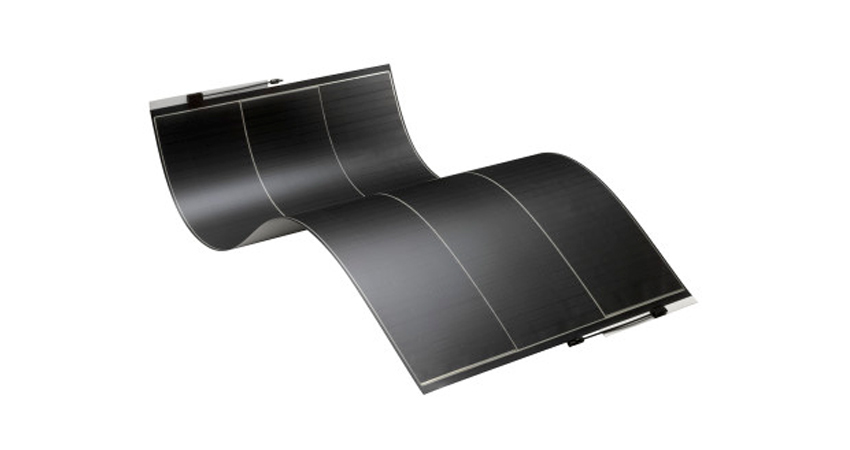What are thin film solar panels, how do they work and why aren’t they used for residential solar systems?
Written by Andrew Sendy
Updated August 12, 2021
10 minutes read
Categories: Solar 101, Solar panels, Solar power

Image source: Solopower
Advances in technology usually lead to a smaller size, decreased weight, new features, improved lifespan, or lower costs depending on the product. Solar panels are no different. The design of today’s solar panels is a great improvement than that of their predecessors. And they cost less too, which makes them more affordable to homeowners. One advance in solar panel technology is the introduction of thin-film solar panels. If you are shopping for a residential solar system, you might think that these thinner panels would be ideal for your home. However thin-film solar panels are recommended for commercial applications and here’s why.
What is a thin film solar panel?
A thin-film solar panel is made up of one or more thin layers of photovoltaic materials that are laid onto a substrate. These thin layers with their multiple light absorbing layers can be over 300 times smaller than a traditional silicon solar panel. Because of the size of the photovoltaic cells used with built-in semi-conductors, thin-film solar panels are the lightest panels available.
How are thin solar panels made?
Thin-film solar panels are differentiated by the type of substrate that is used in their manufacturing. There are four types of substrates used, including:
- Cadmium telluride (CdTe). This type of substrate is the most used with manufacturing thin-film solar panels and holds 50 percent of market share. An issue with using thin-film panels with a CdTe is that they contain a large amount of Cadmium, which is a toxic element. These panels have an efficiency range of 9-11 percent but have been tested up to 18.7 percent.
- Amorphous silicon (a-Si). Solar cells manufactured with amorphous silicon have been typically less efficient and geared more toward small-scale applications. But through the manufacturing process of “stacking” several layers, the efficiency of a-Si thin-film solar panels have higher efficiency rates around 6-8 percent. This type of thin-film panel follows CdTe panels in popularity. They are also less toxic and more durable than CdTe and CIGS thin-panels.
- Copper indium gallium selenide (CIGS). Thin-film solar panels made with a copper indium gallium selenide substrate contain less toxic cadmium than CdTe cells. The manufacturing of these solar panels began in Germany during 2011, but they are now also made in the United States and China. CIGS panels have shown potential in laboratory testing for high-efficiency, put in real-world use, they have shown an efficiency of 10-12 percent.
- Gallium arsenide (GaAs). Thin-panel solar panels made with gallium arsenide are considered the most efficient of all thin-panels with a high of 28.8 percent. However, because of their cost, they are typically used in building spacecrafts and other types of specialized applications where PV energy is required.
Where can you get thin solar panels?
Thin-film solar panels are made through various manufacturers, including these leading manufacturers:
- First Solar who leads with CdTe technology
- SoloPower who is a leader in CIGS manufacturing
- Sharp who is a top manufacturer of a-Si and has been in the PV business since 1959
- Solar Frontier from Japan is the world’s top manufacturer of CIGS
Keep in mind when purchasing solar panels, you are likely to have higher levels of satisfaction when buying from local solar panel installers rather than going straight to the manufacturer.
How do thin solar panels compare to traditional solar panels?
Thin solar panels have an advantage over traditional solar panels for several reasons:
- They are lightweight because of their construction where the panels are sandwiched between glass without a frame
- Cost less than traditional solar panels
- Have less of an impact on the environment because they use less silicon
- Installation usually costs less because they are easy to install and require less labor
However, thin-film solar cells due do have a few cons:
- If the thin-panels contain toxic cadmium, their impact on the environment increases instead of decreases
- They are not as efficient as traditional solar panels are for residential use, where PVs in the traditional range between 13-19 percent efficiency and thin-film average between 4-12 percent
- A larger area, possibly up to 50 percent more is needed depending on project size to allow for more thin-film solar panels
- While labor costs are reduced, special installation materials may be required
In what situations are thin-film solar panels the best?
Because thin-film solar panels require larger installation areas, they are not usually recommended for residential installations. They are more geared toward commercial and utility applications where more space is available for a grander scale installation.
How much do thin-film solar panels cost?
The price of solar technology, including thin-film solar panels continues to drop throughout the United States. When comparing prices for a thin-film solar panel installation versus a traditional silicon wafer solar panel, you need to consider:
- The entire cost of installation
- Your expected savings on your electric bill
- How long it will take before you will realize a return on your investment
You can get an estimate of your solar system costs and savings, which also includes all the local incentives you might be eligible for.
